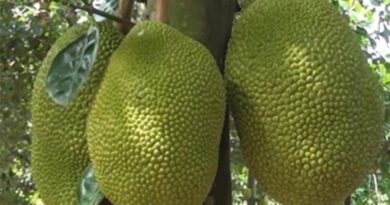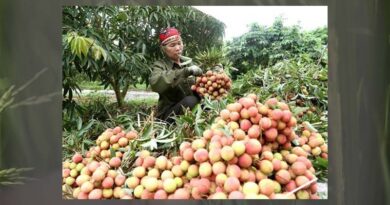Agricultural, forestry and fishery export turnover reaches record high in 2021
30 December 2021, Vietnam: Export turnover of agricultural, forest and fishery products in Vietnam reached a record high of US$48.6 billion this year, an increase of nearly 15 per cent compared to 2020.
As well as reaching a record high, turnover was also $4.6 billion more than the target set for the country’s agriculture sector earlier this year.
Speaking at a meeting on Wednesday to review this year’s performance of agriculture sector, Deputy Minister of Agriculture and Rural Development Phung Duc Tien proudly reported that in 2021, ten Vietnamese agriculture products had a turnover of over $1 billion, and six had a turnover of more than $3 billion, which are timber, shrimp, vegetable and fruits, cashew, rice and rubber products.
Export turnover of timber and forestry products is estimated to reach $15.6 billion this year, accounting for more than 30 per cent of the total export turnover of agricultural, forestry and fishery products.
Vietnam is now ranked first in ASEAN, second in Asia and fifth in the world in terms of timber and forestry product export.
Vietnam enterprises generated $8.9 billion from exporting aquaculture products, despite most aquaculture export activities being halted for three months due to the COVID-19 pandemic.
Deputy Minister Tien said that in facing the challenges and difficulties of the COVID-19 pandemic, the agriculture industry took drastic but flexible measures.
Crop production became more efficient and reached 43.86 million tons, meeting the demand for both domestic consumption and export.
The proportion of high-quality rice accounted for over 89 per cent of total rice production and the price of exported rice increased from $496 per ton in 2020 to $503 per ton in 2021.
The total area of fruit trees reached 1.18 million hectares, an increase of 44,800 hectares compared to 2020. The output and quality of fruit trees in every region increased with some yields increasing from five to 19 per cent.
Regarding livestock production, more farms applied clean, organic farming and biosafety measures.
Meat output of all kinds reached 6.69 million tonnes, up 3.2 per cent compared to 2020.
Fresh milk output reached over 1.2 million tonnes, up 10.5 per cent.
The country produced about 17.5 billion eggs, up 5.1 per cent over last year.
In the fisheries sector, the sustainable development of both farming and fishing were accelerated. Total aquacultural production reached over 8.73 million tonnes, up 1.0 per cent compared to 2020.
Tien said that agricultural restructuring was more practical and effective during 2021 and led to increased production size and levels.
Agricultural production has been shifting towards commodity production based on promoting the advantages of each region and locality.
The agricultural product consumption market continued to develop locally and internationally.
Vietnam’s agriculture sector also paid more attention to developing production-supply chains, better linking farmers and cooperatives with enterprises, Tiến said.
In 2021, 1,250 new agricultural cooperatives were established, bringing the total number of agricultural cooperatives in the country to 19,100.
About 1,649 enterprises were established or re-opened this year, bringing the total number of agricultural enterprises to 14,400.
More to do
Applauding positive results that the agriculture sector did this year, Prime Minister Pham Minh Chinh said that the sector closely followed real situations and directions of the Government to implement solutions, innovations and resolutions to raise the value of farming products.
However, the PM said that the development of the agricultural sector has not yet realised its full potential. For example, agriculture production and consumption still rely heavily on particular markets, weather and other factors which limit capacity.
Up to this point, Vietnam’s agricultural industry has not developed sustainably nor taken advantage of science, technology and digital transformation. The export market is not yet diversified, leaving a heavy reliance on certain markets.
“As a result, when exporters make changes, we will be confused and passive,” Chinh said.
Also Read: Dhanuka along with PJTSAU to introduce new technologies to Telangana farmers
Another example PM Chinh gave was that Vietnam’s rice export turnover was $3 billion, but $7-8 billion was spent on importing corn and soybean. The PM urged agriculture to solve this problem.
“We must determine that 2022 will be more difficult than 2021. It is necessary to identify key tasks to allocate resources reasonably,” he said.
Chinh also emphasised the importance of long-term planning and strategy for the sector.
He asked for an improved legal framework to facilitate sustainable agriculture with further scientific and technologic applications, digital transformation and increased labour productivity.
Chinh said that first it was necessary to diversify products, improve product quality and develop strong branding for Vietnamese agricultural products.
“To fully take advantage of the 17 free trade agreements that Vietnam has with more than 60 countries, Vietnamese products need a brand,” he said.
“We need to improve food processing capacity, develop large raw material areas for commodity production, apply advanced sciences and technology in agriculture production,” he said.
Regarding the blockage of Vietnamese farming products at border gates, the PM said that once the country develops high-quality products that meet import requirements, the products will pass any technical barriers and entering overseas markets will become easier./.















